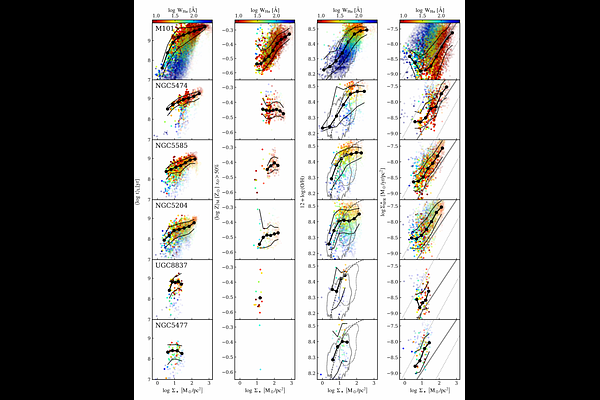Spatially resolved stellar populations and emission lines properties in nearby galaxies with J-PLUS -- I. Method and first results for the M101 group

Spatially resolved stellar populations and emission lines properties in nearby galaxies with J-PLUS -- I. Method and first results for the M101 group
J. Thainá-Batista, R. Cid Fernandes, R. M. González Delgado, J. E. Rodríguez-Martín, R. García-Benito, G. Martínez-Solaeche, L. A. Díaz-García, V. H. Sasse, A. Lumbreras-Calle, A. M. Conrado, J. Alcaniz, R. E. Angulo, A. J. Cenarro, D. Cristóbal-Hornillos, R. A. Dupke, A. Ederoclite, C. Hernández-Monteagudo, C. López-Sanjuan, A. Marín-Franch, M. Moles, L. Sodré Jr., H. Vázquez Ramió, J. Varela
AbstractSpatially resolved maps of stellar populations and nebular emission are key tools for understanding the physical properties and evolutionary stages of galaxies. We aim to characterize the spatially resolved stellar population and emission line properties of galaxies in the M101 group using Javalambre Photometric Local Universe Survey (J-PLUS) data. The datacubes first go through pre-processing steps, which include masking, noise suppression, PSF homogenization, and spatial binning. The improved data are then analyzed with the spectral synthesis code \alstar, which has been previously shown to produce excellent results with the unique 12 bands filter system of J-PLUS and S-PLUS. We produce maps of stellar mass surface density ($\Sigma_\star$), mean stellar age and metallicity, star formation rate surface density ($\Sigma_{\rm SFR}$), dust attenuation, and emission line properties such as fluxes and equivalent widths of the main optical lines. Relations among these properties are explored. All galaxies exhibit a well-defined age-$\Sigma_\star$ relation, except for the dwarfs. Similarly, all of the galaxies follow local $\Sigma_\star$-$\Sigma_{\rm SFR}$ star-forming MS relations, with specific star formation rates that grow for less massive systems. A stellar $\Sigma_\star$-metallicity relation is clearly present in M101, while other galaxies have either flatter or undefined relations. Nebular metallicities correlate with $\Sigma_\star$ for all galaxies. This study demonstrates the ability of J-PLUS to perform IFS-like analysis of galaxies, offering robust spatially resolved measurements of stellar populations and emission lines over large fields of view. The M101 group analysis showcases the potential for expanding such studies to other groups and clusters, contributing to the understanding of galaxy evolution across different environments.